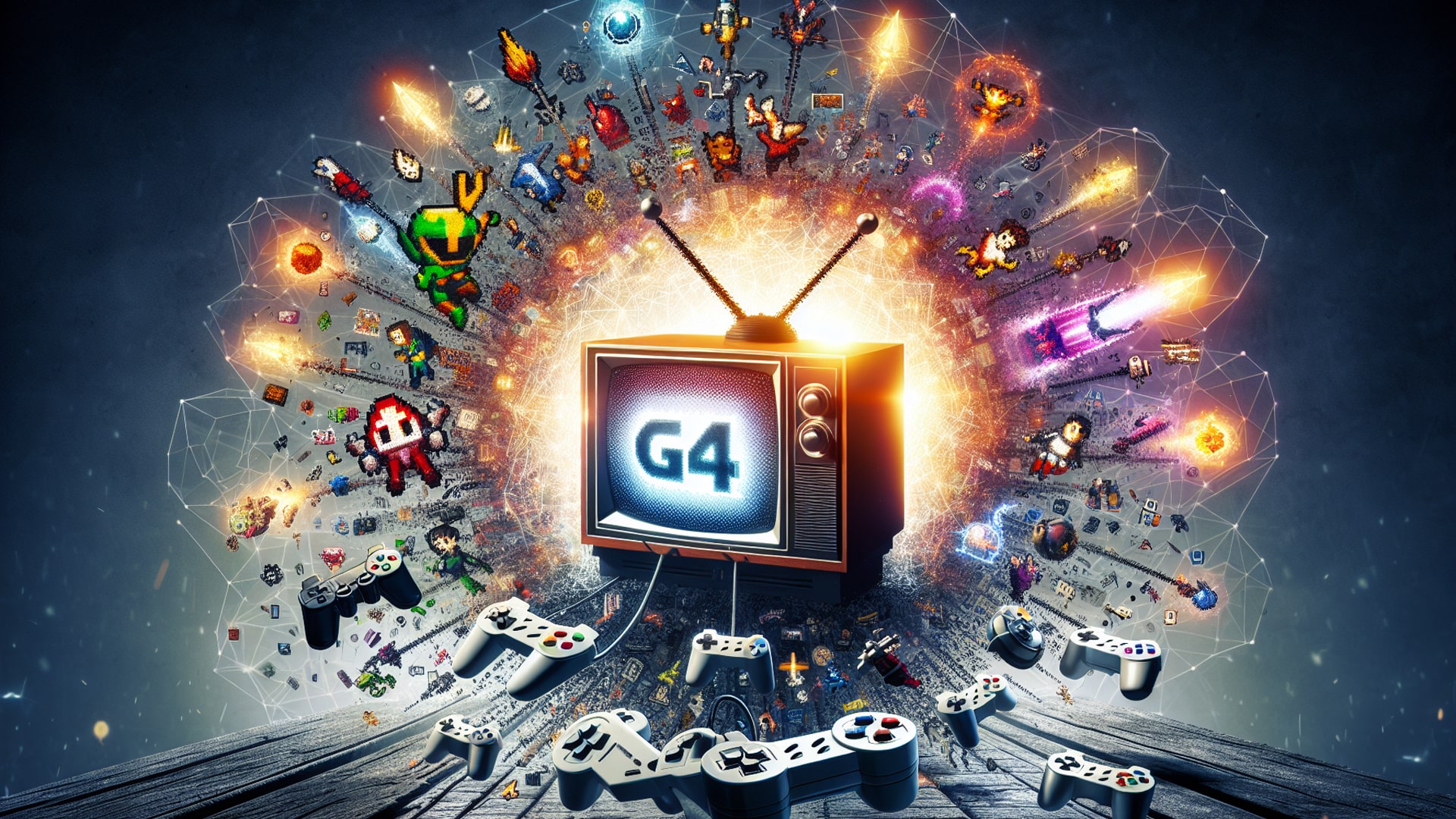The Rise and Fall of G4 TV: History of Iconic Gaming Network
Why did G4 TV, the iconic gaming network, fall into oblivion? This article delves into G4’s ambitious comeback, battles with the new era’s giants like YouTube and Twitch, and the internal discord that extinguished its chances at revival.
Key Takeaways
- G4 TV was ultimately shut down due to low viewership and a lack of a clear audience strategy, despite attempts at a resurgence and various content strategies to adapt to modern gaming audiences.
- Behind-the-scenes issues including leadership changes, employee dissatisfaction, and departures contributed significantly to the network’s instability and fall, highlighting the importance of stable management and clear company direction.
- Financial challenges faced by G4 TV were compounded by broader industry trends such as the rise of online streaming platforms and a shift in consumer preferences away from traditional cable, resulting in an unsustainable business model.
Disclaimer: The links provided herein are affiliate links. If you choose to use them, I may earn a commission from the platform owner, at no extra cost to you. This helps support my work and allows me to continue to provide valuable content. Thank you!
The Unplugging of an Icon

G4 TV, once an online and TV destination, and dish network for gamers worldwide, met an untimely end as Comcast Spectacor pulled the plug on the network and the channel shut. A plethora of factors contributed to this decision, with low viewership of the network dedicated to gamers and an unclear audience strategy being at the forefront. Despite its status as a gaming content hub, the network faced significant challenges in achieving sustainable financial results. The network’s months of hard work appeared to yield few results, culminating in the difficult conclusion to discontinue G4’s operations.
The news came as a shock to many, especially the employees who had worked hard to make G4 a go-to TV destination for gaming enthusiasts. Scott, chairman of the board, penned a heartfelt letter to the employees, expressing his gratitude for their dedication and expressing his regret at the decision. The announcement was met with disappointment across the gaming community, with many lamenting the loss of their favorite gaming network.
The Brief Resurgence
Faced with these challenges, G4 strove for a resurgence to regain its previous stature. On November 16, 2021, Comcast announced G4 would be officially relaunched, ready to take on the modern gaming landscape, with the hope it would have achieved sustainable financial results. With an aim to engage the audience in its talent hunt, the network uploaded a video featuring former X-Play host Adam Sessler on its official YouTube channel. Fans were invited to apply to become G4 hosts or nominate their favorite personalities, a move that resonated with the fanbase.
The relaunch saw the introduction of new hosts, including co host wrestler Xavier ‘King’ Woods and Olivia Munn, who was reportedly in final negotiations for a multi-year deal with G4. Despite these efforts, the network struggled to find its footing in the modern gaming landscape. The challenges of competing with established platforms like YouTube and Twitch, coupled with the changing dynamics of the gaming industry, proved to be significant hurdles.
Struggling to Connect
G4 TV’s attempts to reach its audience on new platforms frequently seemed like a constant struggle to gain traction. The network made continuous adjustments to its strategy in response to consistently low viewership, without providing sufficient time for any content to gain momentum. The frequent alterations in shows’ platforms and formats, rather than focusing on linear television, had a detrimental effect on the network’s fundamental structure, and the human resources team had to adapt to these changes.
G4’s expansion to platforms like Twitch and YouTube, along with its return to traditional linear television, were part of its strategy to become a popular TV destination for gaming enthusiasts. However, the specialized and well-produced content designed for each platform, such as esports and gaming culture shows, failed to capture the audience’s interest like when the network originally launched. The absence of stable metrics for success further compounded the network’s struggles, leading to the disappointing news of G4 TV’s cessation.
Behind the Scenes Turmoil

Behind the scenes, G4 TV was a hotbed of turmoil. Frequent changes in leadership and the departure of key staff members led to a state of constant flux within the company. From Neal Tiles’ departure to Adam Stotsky assuming the role of CEO and the subsequent appointment of Russell Arons as president, the network saw a revolving door of leaders. The frequent changes may have resulted in reduced morale and productivity among employees, further impacting the network’s overall performance.
This period of instability was marked by:
- tension and confusion
- challenges in upholding a clear direction
- absence of consistent leadership
- impact on distribution deals with providers like Time Warner Cable
- financial struggles
- behind-the-scenes turmoil
- public struggles
All of these factors created a perfect storm that would eventually lead to the network’s downfall.
Leadership Roulette
At the network’s helm, there was an ongoing cycle of leadership changes. Key decision-makers, including Dave Scott, chairman of the board, Tucker Roberts, and Russell Arons, took turns in steering the ship, often leading to confusion and tension within the company. The changes in leadership resulted in constant pivots, increased costs, and controversy, having a detrimental effect on the work environment and contributing to the network’s collapse.
Russell Arons’ departure was particularly contentious. Following a heated all-hands meeting where she faced criticism from talent regarding a lack of transparency, failure to implement promised diversity initiatives, and other issues, Arons left G4 TV. Her departure was announced as effective immediately, raising concerns about the company’s investment in the network’s future.
Employee Exodus
As leadership changes persisted, the network experienced a mass departure of a few dozen employees. The constant changes and lack of clear direction fostered confusion and uncertainty among employees, leading to decreased morale and productivity. An absence of clear direction can result in an employee exodus, as it leaves employees with unclear expectations and a lack of a sense of direction.
The departure of key staff members further weakened G4’s foundation, making it difficult for the network to maintain its operations. As the pillars of the network left, the foundation crumbled, leading to an inevitable collapse. This exodus of employees was the final straw that broke the camel’s back, bringing an end to the network that had once been an icon in the gaming industry.
Financial Hurdles and Viewer Dynamics
In addition to the internal turmoil, G4 TV grappled with financial challenges. The changing dynamics of the cable industry, specifically the decline in revenue due to cord-cutting trends, further exacerbated G4’s financial struggles. The network was given a challenging $19 million income goal by Comcast, putting additional pressure on its already strained finances.
G4 TV’s financial woes were not just due to the changing cable industry dynamics. The network also struggled to adapt to the evolving viewer preferences. The emergence of streaming services such as Twitch and YouTube Gaming led to a shift away from traditional cable TV among audiences. Despite G4’s attempts to adjust its format and platform to align with these trends, it failed to resonate with the modern audience, contributing to its eventual downfall.
Cable Providers' Woes
G4 TV’s dependence on traditional TV revenue became increasingly unsustainable as cable providers confronted their own difficulties. The challenges that cable providers encountered, such as declining ratings and subscriber counts, had a significant impact on G4 TV. The decline in market share of cable TV providers, influenced by the rise of online video and high-speed internet, led to a decrease in revenue for G4 TV.
G4 TV was notably dependent on traditional TV revenue, as it was assigned a $19 million income target by Comcast. This dependence on cable distribution, in addition to other revenue sources such as Twitch subscriptions, sponsorships, and merchandise sales, highlighted the network’s financial struggles and the company’s investment risks. These financial woes, coupled with the challenges faced by cable providers, put G4’s financial model at risk.
Content Conundrum
In spite of its financial struggles, G4 TV strived to create content appealing to contemporary audiences. The network made numerous adjustments to its content strategy to align with viewer trends, which included the relaunch of classic shows such as Attack of the Show! and Xplay. However, these attempts often fell short, leaving viewers dissatisfied and disinterested.
G4’s efforts to create engaging content were met with criticism from its viewers. Concerns ranged from the absence of familiar talent and a mismatch of network TV style content with Twitch, to extravagant and costly production. Ultimately, the network’s inability to produce content that resonated with the audience led to disappointing news of G4 TV’s cessation.
Cultural Shifts and Harassment Scandals

Cultural shifts in the gaming industry and harassment scandals further compounded G4 TV’s woes by significantly damaging the network’s reputation. As the gaming landscape evolved, G4 TV struggled to adapt and maintain its relevance. The rise of online video and high-speed internet significantly decreased G4 TV’s viewership and relevance, further contributing to its downfall.
The network’s decline was further exacerbated by:
- Harassment scandals that tarnished its reputation
- Incidents of harassment, threats, and doxing aimed at individuals associated with the network, such as Olivia Munn and Morgan Webb
- Sexist expectations and workplace harassment
- Financial struggles and internal turmoil
These factors, combined, led to the network’s eventual downfall.
Changing Gaming Landscape
The gaming landscape has evolved significantly since G4 TV’s heyday. The rise of online streaming platforms like Twitch has had a substantial impact on traditional gaming networks, creating new connections between developers and influencers, and altering the way individuals consume and interact with video games. As the gaming landscape shifted, G4 TV found it increasingly difficult to maintain its relevance.
The network also struggled to adapt to the shift in viewer preferences. The emergence of new competitors in the gaming media landscape, influenced by the rise of esports and the dominance of gaming in the entertainment industry, brought about changes that G4 struggled to keep up with. Despite its efforts, G4 TV was unable to navigate the changing gaming landscape, leading to its eventual downfall.
Controversy and Support
G4 TV was not only grappling with financial difficulties and a shifting gaming landscape but also had to manage controversy and scandal. Harassment and sexism within the G4 community significantly damaged the network’s image and alienated potential viewers. Controversies surrounding harassment and sexism tarnished the network’s reputation, further contributing to its decline.
Following a controversial on-air rant against sexism in gaming, the network saw a significant drop in viewership, resulting in a drastic fall in ratings. The network’s response to the backlash following the controversy was less than satisfactory, with G4 discreetly removing the supportive tweet and making the YouTube video private, but making no public statements about the incident thereafter.
These controversies, combined with the network’s inability to adapt to the changing landscape of the gaming industry, led to its eventual downfall.
The Impact on Gaming and Pop Culture

Despite its downfall, the influence of G4 TV on gaming and pop culture is undeniable. The network fostered a devoted viewership through the airing of gamer culture shows and leveraging the growing interest in gaming content across different platforms. G4 TV exerted a substantial influence on gaming and pop culture, creating a legacy that continues to resonate with gamers worldwide.
Remembered fondly for its inception in 2002, G4 TV emphasizes an era when it catered to a youthful demographic and commemorated the progression of video games. The network’s influence on gaming was evident in its advocacy for the acceptance of gaming as a mainstream medium, inspiring a fusion of traditional TV and contemporary content creation approaches.
Nostalgia and Influence
The network’s celebrated position in gaming history continues to evoke nostalgia among many fans. The nostalgic appeal of G4 TV is derived from:
- The sense of social connections and community that games evoke
- The longing for the past that video games as a medium can fulfill
- The network’s significant contributions to video game journalism
- Its impact on game development trends
These factors have left a lasting legacy that continues to influence the gaming industry.
Several significant moments in G4 TV’s history have influenced gaming culture, including the reunion of former hosts Adam Sessler and Kevin Pereira, which had a profound emotional impact on fans. The network’s network effects also increased value for the customer as more individuals utilized the product, leading to exposure and prospects for interaction with peers and professionals in the field.
Future of Gaming Media
The downfall of G4 TV serves as a warning for the future trajectory of gaming media. The network’s struggles highlight the importance of adapting to changing industry trends and maintaining a strong, cohesive vision. The gaming media industry is adapting to emerging trends by:
- Welcoming the metaverse
- Bridging the divide between traditional sports and esports
- Tailoring strategies to keep pace with the industry’s dynamic changes
The cessation of G4 TV has had a significant impact on the future of gaming media. The absence of a prominent gaming content platform influences the accessibility of gaming-related programming and coverage. The downfall of G4 TV underscores the difficulties that media networks encounter, emphasizing the necessity for adaptation and resilience in the face of unfavorable economic circumstances.
Summary
The rise and fall of G4 TV is a captivating tale of ambition, struggle, and evolution. From its inception as a beloved gaming network to its eventual downfall, G4 TV’s journey serves as a lesson for future gaming media. Despite the challenges, G4 TV’s impact on gaming and pop culture remains significant, leaving a legacy of nostalgia and influence that continues to resonate with gamers worldwide. As we reflect on the network’s journey, it is clear that the future of gaming media must be built on a strong, cohesive vision, adaptability to changing industry trends, and a commitment to maintaining a positive and inclusive community.
Frequently Asked Questions
Does G4 TV still exist?
No, G4 TV has been discontinued due to low viewership and unsustainable financial results, with its operations ceasing on November 18, 2022.
Why did G4 shut down?
G4 shut down due to lower viewership and inability to achieve sustainable financial results, as stated by Comcast Spectacor CEO Dave Scott.
How can I watch G4?
You can watch G4 on multiple platforms including G4's website, YouTube, Twitch, and cable television providers like Verizon Fios and Xfinity. Look for G4's section on where to watch for more information.
What does G4 stand for?
G4 stands for "Generation 4" and refers to the fourth generation of a product, typically hardware rather than software. It is not to be confused with "4G," which refers to network generations.
How did G4 TV attempt to connect with its audience on new platforms?
G4 TV attempted to connect with its audience on new platforms such as Twitch and YouTube, as well as returning to traditional linear television, but ultimately struggled to make the connection.
Keywords
eventually produce programming, expected video game creators, g4 tv, generation wireless internet service, music video producers, network officially relaunched, video game creators, west coast entertainment operations, who owns g4Useful Links
WTFast Review 2023: VPN vs. Gamer's Private NetworkGaming Directory - 2019 - Mithrie
Author Details
Mazen (Mithrie) Turkmani
I have been creating gaming content since August 2013, and went full-time in 2018. Since then, I have published hundreds of gaming news videos and articles. I have had a passion for gaming for more than 30 years!
Ownership and Funding
Mithrie.com is a Gaming News website owned and operated by Mazen Turkmani. I am an independent individual and not part of any company or entity.
Advertising
Mithrie.com does not have any advertising or sponsorships at this time for this website. The website may enable Google Adsense in the future. Mithrie.com is not affiliated with Google or any other news organization.
Use of Automated Content
Mithrie.com uses AI tools such as ChatGPT and Google Gemini to increase the length of articles for further readablity. The news itself is kept accurate by manual review from Mazen Turkmani.
News Selection and Presentation
The news stories on Mithrie.com are selected by me based on their relevance to the gaming community. I strive to present the news in a fair and unbiased manner.

